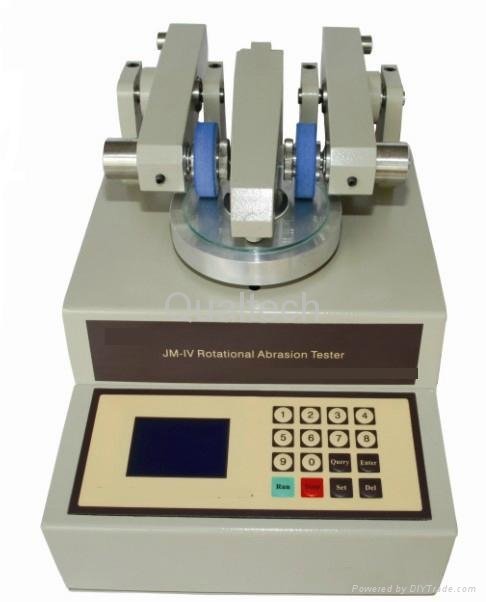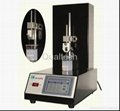| Model: | QPI |
|---|---|
| Brand: | Qualtech |
| Origin: | Made In China |
| Category: | Electronics & Electricity / Electronic Instrument / Laboratory Instrument |
| Label: | Taber abraser , Taber abrasion teste , Taber abrader |
| Price: |
US $2000
/ pc
|
| Min. Order: | 1 pc |
Product Description
Taber Rotary Abraser
Descriptions:
The Rotary Platform Abrasion Tester (commonly referred to as the Taber Abraser or Taber Abrader) was introduced in the 1930's
and has been a popular instrument for evaluating abrasion and wear resistance.
Easy to operate, the Taber Abraser (Abrader) is referenced in numerous internationally recognized test standards
and covers a wide spectrum of materials (including plastics, coatings, laminates, leather, paper, ceramics, carpeting, safety glazing, etc.).
Taber tests involve mounting a flat specimen approximately 100mm square or round to a turntable
platform that rotates on a vertical axis at a fixed speed. The standard material thickness that can
be evaluated with the Taber Rotary Abraser is 6.35 mm (materials greater than 6.35 mm but less
than 40 mm can be tested with optional accessories). Two genuine Taber abrasive wheels, which
are applied at a specific pressure, are lowered onto the specimen surface.Characteristic rub-wear action is produced by contact of the test specimen against the sliding rotation of the two abrading wheels.
As the turntable rotates, the wheels are driven by the sample in opposite directions about a horizontal axis displaced tangentially from the axis of the sample.
One abrading wheel rubs the specimen outward toward the periphery and the other, inward toward the center while a vacuum system removes loose debris during the test.
The wheels traverse a complete circle on the specimen surface, revealing abrasion resistance at all angles relative to the weave or grain of the material.
The resulting abrasion marks form a pattern of crossed arcs in a circular band that cover an area approximately 30 cm2.
Each turntable has dual abrading arms that are precision balanced. Independently operated, the
abrading arms can be raised (or lowered) to mount or inspect specimens. Each arm is loaded for
250 gram pressure against the specimen, exclusive of the weight of the wheel. To increase the
load to 500 or 1000 grams, a mount for auxiliary weights is located on the outside of the abrading
wheel bearing assembly. This location ensures that weights are concentric with the abrading wheel.
Applications:
Taber abraser(abrader) is applicable to determine abrasion resistance performance of coatings and materials of all types.
It can test a wide range of products.The Taber Abraser can be used to test virtually any flat specimen. Its field of application
has included tests of: painted, lacquered, powder coated, and electroplated surfaces; textile fabrics ranging from sheer silks to heavy upholstery and carpeting;
and solid materials such as metals, stone and ceramics. Other materials include paper, glass, plastics, leather, rubber, linoleum, laminates, plus many others.
Principle:
It uses the principle of spinning a test sample under abrasive wheels.These wheels may be made of many different materials
including rubbers, wool, felt, sand paper, details of the principle are as follows:
The rub-wear action is produced by contact of the test sample, turning on a vertical axis, against the sliding rotation of two abrading wheels.
The wheels are driven by the sample in opposite directions about a horizontal axis displaced tangentially from the axis of the sample.
One abrading wheel rubs the specimen outward toward the periphery and the other, inward toward the center.
The resulting abrasion marks form a pattern of crossed arcs over an area approximately 30 square centimeters.
Evaluation
There are various techniques used to interpret results generated with the TABER Rotary Platform
Abraser (Abrader). The method of evaluation that you select should reflect the type of material
that is being tested. If you are following a specification - the method for interpreting test results
will be listed.
The most common methods of evaluating results from the Taber Abraser (Abrader) include:
Cycles to a Specific End-Point - The number of cycles required to reach a predetermined end
point, or the appearance or condition of the specimen after a fixed number of cycles. The
evaluation criteria may include: loss in breaking strength, yarn breakage, loss in coating, change in
gloss, color loss, or other changes in appearance. In these cases, the abraded sample is usually
compared to a known standard of the material tested. When visually inspecting changes in
specimen appearance, evaluations should be made using an agreed upon rating system such as a
visual grading scale (e.g. five-step) or pass/fail criteria.
Weight (Mass) Loss - This technique measures how much material has been removed by abrasion,
and is usually reported in milligrams.
L = A - B
where L = weight loss
A = weight (mass) of specimen before abrasion
B = weight (mass) of specimen after abrasion
When performing the weight loss method, loose particulate may adhere to specimens during
testing. It is critical that you clean off the test specimens as best as possible prior to weighing.
TaberWear Index - Indicates rate of wear, and is calculated by measuring the loss in weight (in
milligrams) per thousand cycles of abrasion. The lower the wear index, the better the abrasion
resistance.
I = [(A- B) * 1000] / C
where I = wear index
A = weight (mass) of specimen before abrasion
B = weight (mass) of specimen after abrasion
C = number of test cycles
Volume Loss - When comparing the wear resistance of materials that have different specific
gravities, a correction for the specific gravity of each material should be applied to give a true
measure of the comparative wear resistance. Calculate the wear index as shown above, and
divide the result by the material's specific gravity. The use of this correction factor provides a
wear index related to the loss in volume of the material to which it is applied. When comparing
materials of different specific gravities, test parameters must be the same including wheel selection and load.
Features:
Qualtech Taber abraser has the following characteristics:
l Loads: standard range includes 500g, 750g and 1000g
l Abradants:QualtechCS10 and CS17 abrasive wheels.
l Trimmer:Allows user to trim the abrasive wheels to operate a perfect and precise test
l Vacuum cleaner: Allows u to do the cleaning job after test
l Test Duration: programmable to long cycles
l Conditions: wet or dry
Standards:
It complies with the following internation standards :
DIN 52347 53109 53754 53799
ISO 5470,9352,3573,4586-2,7784-2
ASTM C217, D1044, D3389,D4060,D5342
Main Technical Parameters:
1. Rotary disk revolution:70±2r/min
2. Specimen chassis:Φ100mm×Φ8mm(center hole)×3mm
3. Dimension of abrasive wheel:Φ50mm×Φ16mm(center hole)×13mm
4. Load weights:500g 750g 1000g
5 Rubber Balance Weights: 20g 10g 5g 2g 1g
5.Main engine: 220V/40W; or 110V/40W
6.Main configuration: Taber abraser 1unit (22×28×30cm) length by width by height
Refacing disk 1unit
Vacuum cleaner 1unit
Load weights:750g(2pcs); 500g(2pcs); 1000g(2pics);
Weights which are used to balance the weight of wheel:20g(2pcs); 10g(2pcs); 5g(2pcs); 2g(2pcs); 1g(2pcs)
Glasses panels 5pcs
Qualtech Rubber abrasive wheels 10 pcs( CS10 5pcs and CS17 5pcs)
Member Information
| Qualtech Products Industry Co.,Ltd | |
|---|---|
| Country/Region: | Shang Hai - China |
| Business Nature: | Manufacturer |
| Phone: | 13798026588 |
| Contact: | Lucy Lee (Sales Manager) |
| Last Online: | 16 Jan, 2015 |








